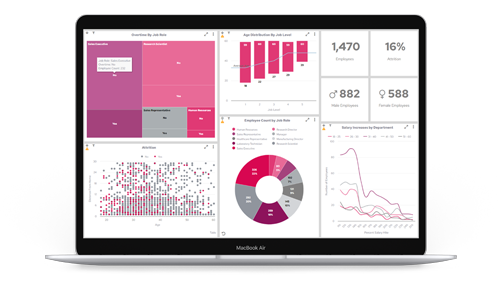Many organizations grapple with the issue of data silos, which can significantly impede their ability to utilize data effectively. Understanding what data silos are, how they form, and the problems they create is the first step towards dismantling these barriers and fostering a more collaborative and integrated data environment. Let's delve into it.
What are data silos?
Data silos are isolated repositories of data within an organization where information is stored and managed separately, often within different departments, teams, or systems. These isolated pockets of data are disconnected from one another, making it difficult to share, access, or analyze information across the organization. This segregation of data can hinder collaboration, decision-making, and efficiency.
Data silos typically emerge due to departmental specialization, legacy systems, or even organizational politics. Each department becomes a guardian of its own data, often unaware of the bigger picture. The longer data is isolated, the more challenging it can be to break down silos, so it’s crucial to act swiftly when data silos occur. Ideally, organizations should aim to prevent data silos from forming in the first place.
How data silos occur
Data silos often arise due to a combination of organizational and technological factors. A prevalent cause is the use of different systems and software across various departments. For instance, the finance department might utilize one type of accounting software, while the human resources department employs another for employee management. These systems may not be designed to communicate with each other, resulting in isolated data pools. Here are some key factors that contribute to the formation of data silos:
- IT strategy and technology deployments: Decentralized IT purchasing decisions can lead to incompatible systems. When individual departments or business units are allowed to make their own IT purchasing decisions without a centralized strategy, they often choose systems that best meet their specific needs. However, these systems may not be compatible with those used by other departments, resulting in isolated data silos.
- Organizational structure and management: Fully decentralized business units often operate as separate entities. In organizations where business units have a high degree of autonomy, each unit may develop its own processes and systems independently. This can lead to a lack of standardization and integration across the organization, creating data silos as each unit operates in isolation.
- Business growth and acquisitions: Expansion and mergers can introduce new, isolated data systems. As companies grow and acquire other businesses, they often inherit a variety of legacy systems and databases. Integrating these disparate systems can be challenging, leading to the creation of new data silos as the organization struggles to unify its data landscape.
- Organizational culture: In some cases, departments may be reluctant to share data due to concerns about data privacy, security, or simply a lack of trust. This can create a culture of data hoarding, where information is closely guarded rather than shared openly.

How do you identify data silos?
By pinpointing areas where data is isolated, you can take proactive measures to bridge these gaps and promote a more unified data strategy. Here are some practical steps to help you identify data silos:
- Conduct a comprehensive audit of all data repositories and systems used across different departments.
- Look for signs of isolated data pools, such as departments using different software for similar functions.
- Check for data that is not easily accessible by other teams.
- Survey employees to understand their data access and sharing practices.
- Identify if employees frequently mention difficulties in obtaining data from other departments.
- Look for noticeable inconsistencies in data formats and standards.
- Regularly review data workflows and communication channels to spot and address data silos early.
Why are data silos problematic?
Data silos hinder business operations and the initiatives that support them. Silos can be highly problematic for several reasons, for example:
- Reduced efficiency: When data is not shared across departments, employees may spend unnecessary time and effort duplicating work or manually transferring information between systems.
- Inconsistent data: Different departments may have conflicting or outdated versions of the same data, leading to inconsistencies and errors in decision-making.
- Limited insights: Isolated data pools prevent organizations from gaining a comprehensive view of their operations, hindering their ability to make informed, data-driven decisions.
- Increased costs: Maintaining multiple, incompatible systems can be costly in terms of both time and resources, as organizations may need to invest in additional tools or personnel to manage these systems.
- Security risks: Data silos can create vulnerabilities, as fragmented data management practices may lead to gaps in security protocols, increasing the risk of data breaches.
How do you break down data silos?
Breaking down data silos is essential for fostering a collaborative and efficient organizational environment. Here are some strategies to help you dismantle these barriers in 6 steps:
1. Put the right tools in place
To achieve a single source of truth, you’ll need to ingest data from across the organization and build a unified view. There are a variety of systems that help with this effort:
- Data lake: A data lake stores all your data in its raw form. These can be as simple as a CSV file, but they don’t give you a lot of flexibility with your data.
- Customer relationship management (CRM) systems: CRMs are generally cloud-based software suites designed to administer all your customer data. However, a constant challenge with CRMs is ensuring all the data is accurate and translating that data into an action plan.
- Master data management (MDM): MDMs unify all data into an official master data asset. Though this can solve the data silo problem, it usually has a latency of 24 hours or more before your data becomes actionable.
- Customer data platform (CDP): A CDP collects customer data from various sources in your tech stack to build unified profiles for insights and personalized customer experiences. A key difference between a CDP and the other systems listed here is the ability to connect to downstream systems of activation (for example, onsite personalization, paid media, email, call center, and so on), and to serve the needs of marketing use cases as well as other teams within the organization.
2. Implement a centralized data strategy
Develop a unified data management plan that aligns with the organization's goals. This strategy should include standardized data formats, centralized data repositories, and integrated systems to ensure seamless data sharing across departments. By having a centralized approach, you can eliminate redundancies and ensure that all departments are on the same page regarding data usage and management.
For example, a retail company might implement a centralized data warehouse that consolidates sales, inventory, and customer data from all its stores and online platforms. This allows for real-time analytics and reporting, enabling better inventory management and personalized marketing strategies.
3. Promote a data-sharing culture
Encourage a culture of transparency and collaboration by incentivizing data sharing. Educate employees on the benefits of data integration and provide training on how to use shared data systems effectively. Recognize and reward teams that actively participate in data sharing initiatives, thereby fostering a sense of collective responsibility towards data management.
4. Establish data governance policies
Implement robust data governance frameworks to ensure data quality, consistency, and security. Define clear roles and responsibilities for data management and establish protocols for data access and sharing. Regularly review and update these policies to adapt to changing organizational needs and technological advancements, ensuring that data governance remains effective and relevant.
For example, a financial institution might establish data governance policies that include:
- Data stewardship: Assigning data stewards in each department responsible for maintaining data quality and ensuring compliance with governance policies.
- Access controls: Implementing role-based access controls to ensure that only authorized personnel can access sensitive data, thereby enhancing data security.
- Data quality standards: Defining data quality standards and metrics to regularly assess and improve the accuracy, completeness, and consistency of data across the organization.
- Data sharing protocols: Establishing clear protocols for data sharing between departments, including guidelines on data formats, transfer methods, and security measures to ensure seamless and secure data exchange.
- Regular audits: Conducting regular audits to ensure compliance with data governance policies and to identify areas for improvement, thereby maintaining the integrity and reliability of the organization's data assets.
5. Regularly review and update systems
Conduct periodic audits of your data systems to identify and address any emerging silos. Stay updated with the latest technological advancements and continuously improve your data integration processes. Regular reviews can help you catch potential issues early and make necessary adjustments before they become significant problems.
6. Foster cross-departmental collaboration
Create opportunities for different departments to work together on projects and share insights. Cross-functional teams can help break down barriers and promote a more integrated approach to data management. Encourage regular inter-departmental meetings and collaborative projects to build trust and facilitate the free flow of information across the organization. Examples of fostering cross-departmental collaboration include:
- Joint workshops: Organize workshops where teams from different departments come together to solve common problems or brainstorm new ideas.
- Shared goals: Set common objectives that require input and cooperation from multiple departments, ensuring everyone works towards the same end.
- Inter-departmental committees: Form committees with representatives from various departments to oversee data integration projects and ensure alignment.
- Collaborative tools: Implement collaboration tools like shared dashboards, project management software, and communication platforms to facilitate seamless interaction between departments.
- Regular cross-departmental meetings: Schedule regular meetings where departments can update each other on their progress, share insights, and discuss challenges.

In conclusion, data silos present significant challenges to organizational efficiency, decision-making, and security. By understanding how data silos form and identifying their presence within your organization, you can take proactive steps to dismantle these barriers. Implementing a centralized data strategy, promoting a culture of data sharing, leveraging technology, establishing robust data governance policies, and fostering cross-departmental collaboration are all essential strategies for breaking down data silos. By addressing these issues head-on, organizations can unlock the full potential of their data, leading to improved efficiency, better decision-making, and a more cohesive and collaborative work environment.























